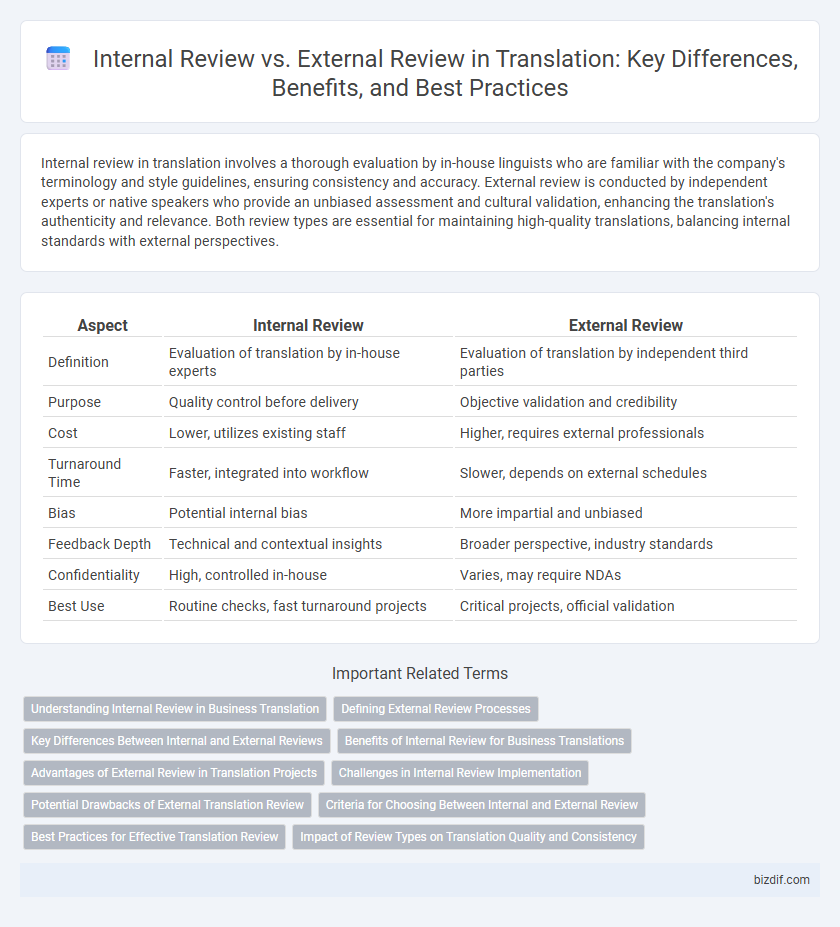Internal review in translation involves a thorough evaluation by in-house linguists who are familiar with the company's terminology and style guidelines, ensuring consistency and accuracy. External review is conducted by independent experts or native speakers who provide an unbiased assessment and cultural validation, enhancing the translation's authenticity and relevance. Both review types are essential for maintaining high-quality translations, balancing internal standards with external perspectives.
Table of Comparison
| Aspect | Internal Review | External Review |
|---|---|---|
| Definition | Evaluation of translation by in-house experts | Evaluation of translation by independent third parties |
| Purpose | Quality control before delivery | Objective validation and credibility |
| Cost | Lower, utilizes existing staff | Higher, requires external professionals |
| Turnaround Time | Faster, integrated into workflow | Slower, depends on external schedules |
| Bias | Potential internal bias | More impartial and unbiased |
| Feedback Depth | Technical and contextual insights | Broader perspective, industry standards |
| Confidentiality | High, controlled in-house | Varies, may require NDAs |
| Best Use | Routine checks, fast turnaround projects | Critical projects, official validation |
Understanding Internal Review in Business Translation
Internal review in business translation involves a thorough examination of translated content by in-house linguists or subject matter experts to ensure accuracy, terminology consistency, and alignment with company standards. This process enhances quality control by addressing context-specific nuances and maintaining brand voice across multilingual materials. Internal review reduces risks associated with miscommunication and supports compliance with industry-specific regulations, fostering reliable and effective global business communication.
Defining External Review Processes
External review processes in translation involve independent linguists or agencies evaluating translated content to ensure accuracy, cultural relevance, and terminology consistency. This phase often includes formal quality assessment tools like bilingual reviews, back-translations, and client feedback integration. Establishing clear guidelines and communication channels is crucial for aligning external reviewers with project-specific standards and minimizing post-delivery revisions.
Key Differences Between Internal and External Reviews
Internal reviews involve assessments conducted by team members within the organization, ensuring alignment with company standards and facilitating immediate feedback. External reviews engage independent experts or native language professionals, offering unbiased quality control and culturally accurate translations. Key differences include the scope of expertise, objectivity, and potential cost impact on translation quality assurance processes.
Benefits of Internal Review for Business Translations
Internal review in business translations enhances accuracy by leveraging subject-matter experts familiar with company terminology and context. It accelerates turnaround times, reducing costs compared to external agencies while maintaining confidentiality of sensitive documents. Consistent internal feedback loops improve quality and ensure alignment with brand voice and industry standards.
Advantages of External Review in Translation Projects
External review in translation projects enhances quality assurance by involving independent experts who provide objective feedback, reducing the risk of bias inherent in internal assessments. It ensures cultural and contextual accuracy through fresh perspectives that internal teams may overlook, improving the overall localization effectiveness. Leveraging external reviewers also accelerates throughput by distributing workload and accessing specialized linguistic expertise tailored to specific market demands.
Challenges in Internal Review Implementation
Internal review in translation often faces challenges such as limited linguistic diversity and potential bias due to reviewers' familiarity with the source material. This can result in inconsistent quality assessments and overlooked contextual nuances. Ensuring standardized criteria and training for internal reviewers is critical to mitigate these issues and improve translation accuracy.
Potential Drawbacks of External Translation Review
External translation review can introduce delays due to the need for extended communication loops between translators and external reviewers. Confidentiality risks arise as sensitive content is exposed outside the organization, increasing the threat of data leaks. Inconsistent feedback from external reviewers may compromise translation quality and disrupt project coherence.
Criteria for Choosing Between Internal and External Review
Selecting between internal and external review hinges on criteria such as expertise specificity, confidentiality requirements, and cost considerations. Internal reviews leverage in-house linguistic and subject-matter experts to ensure alignment with company terminology and style, ideal for sensitive or proprietary content. External reviews provide objective assessment and industry-standard quality control, preferred when specialized knowledge or unbiased validation is mandatory.
Best Practices for Effective Translation Review
Internal review in translation leverages in-house linguistic experts who possess domain-specific knowledge and familiarity with company terminology, ensuring consistency and alignment with brand voice. External review incorporates fresh perspectives from native speakers or specialized translators that enhance cultural accuracy and detect subtle errors or localization issues. Combining both internal and external review stages, utilizing clear guidelines, and maintaining detailed feedback loops optimize translation quality and ensure effective adaptation across diverse markets.
Impact of Review Types on Translation Quality and Consistency
Internal review in translation leverages the translator's familiarity with project-specific terminology and style, enhancing consistency and accuracy across documents. External review introduces an unbiased perspective, often identifying errors and cultural nuances that internal reviewers may overlook, thereby improving overall translation quality. Combining both review types creates a comprehensive validation process, maximizing linguistic precision and maintaining terminological consistency.
Internal Review vs External Review Infographic

 bizdif.com
bizdif.com